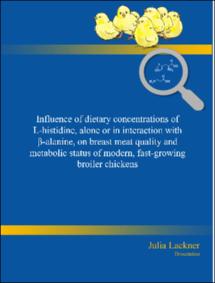Lackner, Julia: Influence of dietary concentrations of L-histidine, alone or in interaction with β-alanine, on breast meat quality and metabolic status of modern, fast-growing broiler chickens. - Bonn, 2022. - Dissertation, Rheinische Friedrich-Wilhelms-Universität Bonn.
Online-Ausgabe in bonndoc: https://nbn-resolving.org/urn:nbn:de:hbz:5-69033
Online-Ausgabe in bonndoc: https://nbn-resolving.org/urn:nbn:de:hbz:5-69033
@phdthesis{handle:20.500.11811/10507,
urn: https://nbn-resolving.org/urn:nbn:de:hbz:5-69033,
author = {{Julia Lackner}},
title = {Influence of dietary concentrations of L-histidine, alone or in interaction with β-alanine, on breast meat quality and metabolic status of modern, fast-growing broiler chickens},
school = {Rheinische Friedrich-Wilhelms-Universität Bonn},
year = 2022,
month = dec,
note = {An increasing demand for poultry meat resulted in optimization of broiler chicken’s genetic towards high growth-rates and breast yield in the last decades. This breeding standard led to increased quality problems in breast meat. Various myopathies of the Pectoralis major muscle, such as the woody breast syndrome, the appearance of white stripping and spaghetti meat, result in high economic losses for the industry. Histidine-containing dipeptides, which are acting as natural antioxidants, pH-buffer, and metal ion chelator in skeletal muscle tissue, were found to be depleted in affected breast muscles. The aim of this thesis was to evaluate the effect of different histidine concentrations in feed on the concentration of the dipeptides carnosine and anserine, as well as the overall meat quality. Since the second precursor for the relevant dipeptides is β-alanine, the combination was also considered. Two feeding tests were carried out with commercial, fast-growing broiler breeds. In both experiments, the histidine concentration was varied in feed, based on a feed formulated for commercial use, alone or in combination with the addition of β-alanine. The first study, described in Manuscript I, focused on how the concentration of dipeptides in muscle tissue and blood serum changed, on the performance of the broilers and on the overall meat quality at two slaughter ages, with variation in histidine concentrations in the feed, without or in combination with β-alanine. Based on these results, the second study, described in Manuscript II, focused on the effect of histidine on the occurrence of different myopathies. In Manuscript III, the total metabolism was considered using an untargeted metabolomics analysis, and was performed in plasma samples from the study described in Manuscript I. The results of this work suggest that histidine is the limiting factor for the synthesis of carnosine in the skeletal muscle tissue of broilers. A higher concentration of histidine, and also the addition of β-alanine, had only marginal effects on the growth performance of the birds. The overall meat quality was only slightly affected by the concentration of histidine or the addition of β-alanine in feed, without a clear trend. However, the incidence of myopathies was dependent on the concentration of histidine. A moderate increase showed reduced incidences, whereas a higher concentration increased the incidences. The analysis of metabolic status indicated a possible deficit of folate or cobalamin at higher histidine concentration in broiler feed.},
url = {https://hdl.handle.net/20.500.11811/10507}
}
urn: https://nbn-resolving.org/urn:nbn:de:hbz:5-69033,
author = {{Julia Lackner}},
title = {Influence of dietary concentrations of L-histidine, alone or in interaction with β-alanine, on breast meat quality and metabolic status of modern, fast-growing broiler chickens},
school = {Rheinische Friedrich-Wilhelms-Universität Bonn},
year = 2022,
month = dec,
note = {An increasing demand for poultry meat resulted in optimization of broiler chicken’s genetic towards high growth-rates and breast yield in the last decades. This breeding standard led to increased quality problems in breast meat. Various myopathies of the Pectoralis major muscle, such as the woody breast syndrome, the appearance of white stripping and spaghetti meat, result in high economic losses for the industry. Histidine-containing dipeptides, which are acting as natural antioxidants, pH-buffer, and metal ion chelator in skeletal muscle tissue, were found to be depleted in affected breast muscles. The aim of this thesis was to evaluate the effect of different histidine concentrations in feed on the concentration of the dipeptides carnosine and anserine, as well as the overall meat quality. Since the second precursor for the relevant dipeptides is β-alanine, the combination was also considered. Two feeding tests were carried out with commercial, fast-growing broiler breeds. In both experiments, the histidine concentration was varied in feed, based on a feed formulated for commercial use, alone or in combination with the addition of β-alanine. The first study, described in Manuscript I, focused on how the concentration of dipeptides in muscle tissue and blood serum changed, on the performance of the broilers and on the overall meat quality at two slaughter ages, with variation in histidine concentrations in the feed, without or in combination with β-alanine. Based on these results, the second study, described in Manuscript II, focused on the effect of histidine on the occurrence of different myopathies. In Manuscript III, the total metabolism was considered using an untargeted metabolomics analysis, and was performed in plasma samples from the study described in Manuscript I. The results of this work suggest that histidine is the limiting factor for the synthesis of carnosine in the skeletal muscle tissue of broilers. A higher concentration of histidine, and also the addition of β-alanine, had only marginal effects on the growth performance of the birds. The overall meat quality was only slightly affected by the concentration of histidine or the addition of β-alanine in feed, without a clear trend. However, the incidence of myopathies was dependent on the concentration of histidine. A moderate increase showed reduced incidences, whereas a higher concentration increased the incidences. The analysis of metabolic status indicated a possible deficit of folate or cobalamin at higher histidine concentration in broiler feed.},
url = {https://hdl.handle.net/20.500.11811/10507}
}






